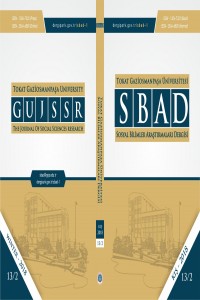Abstract
Osmanlılarda timar sistemi çerçevesinde timar
sahiplerinin sefere götürmekle yükümlü oldukları tam teçhizatlı askere “cebelü”
denilmektedir. Timar sahiplerinin cebelü asker yükümlülüğü kanunnamelerde
düzenlenmiştir. Bu kanunnamelerdeki hükümlere göre, tımarlı sipahiler kendi
dirliklerinin (iptida) üzerindeki her üç bin akçe, zeamet sahipleri ilk beş bin
akçeden sonra her beş bin akçe için bir cebelü sefere götürmeleri
gerekmekteydi. Cebelü yükümlülüğü olan timar ve zeâmet sahipleri cebelü
çıkarmadıklarında, kendilerinden “bedel-i cebelü” adı altında vergi talep
edilirdi. Mevcut literatüre göre, XVII ve XVIII. yüzyıllarda savaş
tekniklerinin değişmesi, timarlı asker ihtiyacının azalması ve hazinenin paraya
olan ihtiyacın artması sebepleriyle cebelü bedeliyesi uygulaması
yaygınlaşmıştır. Cebelü bedeliyesi uygulamasının 17-18. yüzyıllarda yaygınlaşıp
yaygınlaşmadığını tespit etmek için eyalet düzeyinde yeni çalışmalara ihtiyaç
bulunmaktadır. Bu nedenle 1722-23 tarihli Sivas eyaleti Cebelü Bedeliyesi
Defteri analitik bir incelemeye tabi tutulmuştur. Evvela defterdeki bilgiler
tablolaştırılmış, ardından mevcut literatür yardımı ile tablolardaki veriler
değerlendirilmiştir. Değerlendirmeler sonucunda çocuk, mütekait ve diğer timar
ve zeamet sahiplerinin yükümlü oldukları cebelü nefer sayıları; cebelü
bedeliyesinden muaf olanlar; nefer başına ödenen cebelü bedeli; cebelü
bedellerinin tahsili ve Hazine-i Amire’ye teslim usulleri ve cebelü bedeli
gelirlerinin tahsis edildiği hizmetler tespit edilmiştir.
Keywords
References
- BOA. MAD 7603; BOA. MAD 2697
- Akgündüz, A. (1990), Osmanlı Kanunnâmeleri ve Hukukî Tahlilleri, 2. Kitap II. Bâyezid Devri Kanunnâmeleri, İstanbul: Fey Vakfı
- Akgündüz, A. (1992), Osmanlı Kanunnâmeleri ve Hukukî Tahlilleri, 4. Kitap Kanunî Devri Kanunnâmeleri (I), İstanbul: Fey Vakfı.
- Ayn Ali Efendi (1979), Kavânîn-i Âl-i Osman der Hülâsa-i Mezâmîn-i Defter-i Divân, ed. Tayyib Gökbilgin, İstanbul: Enderun Kitabevi.
- Barkan, Ö.L.(1980), “Timar”, Türkiye’de Toprak Meselesi, İstanbul: Gözlem Yayınları, s. 805-872.
- Başbakanlık Osmanlı Arşivi Rehberi (2000), Haz. Yusuf İhsan Genç ve diğerleri, Ankara.
- Emecen, F. (1993), “Cebelü”, DİA, 7: 188-189.
- Genç, M. (2000), Osmanlı İmparatorluğunda Devlet ve Ekonomi, İstanbul: Ötüken Yayınevi.
- İnalcık, H. (1987), Hicrî 835 Tarihli Sûret-i Defter-i Sancak-i Arvanid, Ankara: Türk Tarih Kurumu Basımevi.
- İnalcık, H., “Djebeli”, EI2 (Eng), II, s. 528-529.
- Kütükoğlu, M. (2013), Osmanlı Belgelerinin Dili (Diplomatik), Ankara: Türk Tarih Kurumu Yayını.
- Pakalın, M.Z. (1983), Osmanlı Tarih Deyimleri ve Terimleri Sözlüğü, I, İstanbul: Milli Eğitim Basımevi.
- Sertoğlu, M. (1986), “Cebelü”, Osmanlı Tarih Lûgatı, İstanbul: Enderun Kitabevi.
Abstract
Cebelü is an auxiliary soldier equipped by the
timar-holders who are obliged to take to campaigns in the framework of the
timar system in the Ottomans. The obligations of auxiliary soldier of
timar-holders are designated in the law-books. According to the rules in these
law-books, the timar-holding cavalrymen were to furnish a cebelü for every
3,000 akçes above their own timars; the zeamet-holding cavalrymen who held
timars of more than 20,000 akçes a cebelü for every 5,000 akçes after the first
5,000 akçes of theirs timars. The timar-holding and zeamet-holding cavalrymen
who were to bring with them cebelü, when they did not take cebelü to
campaigns, could pay cash equivalent
for auxiliary soldier levy.
According to the existence literature, the application of pay cash
equivalent for auxiliary soldier levy became widespread in the seventeenth and
eighteenth centuries because of the change of war techniques, decreasing of the
necessity of the timar-holding cavalrymen and increase of the necessity for
money of the treasury. It is necessary to new works in the level of provinces
in order to determine that the application of pay cash equivalent for auxiliary
soldier levy became widespread or not. For this reason, the pay cash equivalent
for auxiliary soldier levy register of 1722-23 of the province of Sivas was
analysed analytically. First of all, the
information in register were put into tables and then the data in tables were
evaluated with the help of the existed literature. In the result of the evaluation,
the number of cebelü obligations of child, retired and other timar-holding and
zeamet-holding cavalrymen; those who excepted from pay cash equivalent for
auxiliary soldier levy; cash equivalent for auxiliary soldier levy paid per
cebelü; the collecting of pay cash equivalent for auxiliary soldier levy and
their ways to deliver to the Treasure; and the services to which the revenues
of pay cash equivalent for auxiliary soldier levy were assigned are determined.
Keywords
Timar pay cash equivalent for auxiliary soldier levy the province of Sivas register military individual
References
- BOA. MAD 7603; BOA. MAD 2697
- Akgündüz, A. (1990), Osmanlı Kanunnâmeleri ve Hukukî Tahlilleri, 2. Kitap II. Bâyezid Devri Kanunnâmeleri, İstanbul: Fey Vakfı
- Akgündüz, A. (1992), Osmanlı Kanunnâmeleri ve Hukukî Tahlilleri, 4. Kitap Kanunî Devri Kanunnâmeleri (I), İstanbul: Fey Vakfı.
- Ayn Ali Efendi (1979), Kavânîn-i Âl-i Osman der Hülâsa-i Mezâmîn-i Defter-i Divân, ed. Tayyib Gökbilgin, İstanbul: Enderun Kitabevi.
- Barkan, Ö.L.(1980), “Timar”, Türkiye’de Toprak Meselesi, İstanbul: Gözlem Yayınları, s. 805-872.
- Başbakanlık Osmanlı Arşivi Rehberi (2000), Haz. Yusuf İhsan Genç ve diğerleri, Ankara.
- Emecen, F. (1993), “Cebelü”, DİA, 7: 188-189.
- Genç, M. (2000), Osmanlı İmparatorluğunda Devlet ve Ekonomi, İstanbul: Ötüken Yayınevi.
- İnalcık, H. (1987), Hicrî 835 Tarihli Sûret-i Defter-i Sancak-i Arvanid, Ankara: Türk Tarih Kurumu Basımevi.
- İnalcık, H., “Djebeli”, EI2 (Eng), II, s. 528-529.
- Kütükoğlu, M. (2013), Osmanlı Belgelerinin Dili (Diplomatik), Ankara: Türk Tarih Kurumu Yayını.
- Pakalın, M.Z. (1983), Osmanlı Tarih Deyimleri ve Terimleri Sözlüğü, I, İstanbul: Milli Eğitim Basımevi.
- Sertoğlu, M. (1986), “Cebelü”, Osmanlı Tarih Lûgatı, İstanbul: Enderun Kitabevi.
Details
| Primary Language | Turkish |
|---|---|
| Journal Section | Articles |
| Authors | |
| Publication Date | December 26, 2018 |
| Submission Date | July 25, 2018 |
| Acceptance Date | November 8, 2018 |
| Published in Issue | Year 2018 Volume: 13 Issue: 2 |
Cite

Bu eser Creative Commons Atıf 4.0 Uluslararası Lisansı ile lisanslanmıştır.


